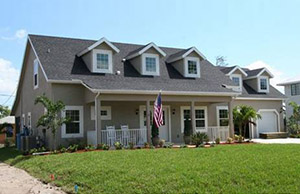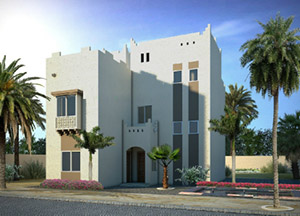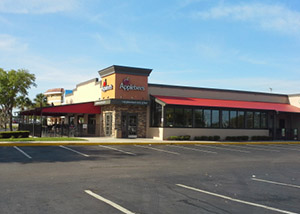Worried About Fire?
 Secure-Lock Steel SIPs meet the requirement to be used as non-combustible exterior walls as defined by the IRC and ICC Co.
Results of ASTM E 84 have shown that the Secure-Lock panel has a superior flame spread rating of 5. When exposed to fire, the panels produce less smoke than wood and do not allow the fire to spread. Secure-Lock steel panels do not "off-gas" as they are completely inert. A Secure-Lock steel SIP home is much safer than a wood frame home. The inner and outer steel skins are continuous and even act as a ground in a lightning strike. Unlike wood, steel is an excellent conductor, offering far less resistance than wood to the current, thus generating much less heat.
Secure-Lock Steel SIPs meet the requirement to be used as non-combustible exterior walls as defined by the IRC and ICC Co.
Results of ASTM E 84 have shown that the Secure-Lock panel has a superior flame spread rating of 5. When exposed to fire, the panels produce less smoke than wood and do not allow the fire to spread. Secure-Lock steel panels do not "off-gas" as they are completely inert. A Secure-Lock steel SIP home is much safer than a wood frame home. The inner and outer steel skins are continuous and even act as a ground in a lightning strike. Unlike wood, steel is an excellent conductor, offering far less resistance than wood to the current, thus generating much less heat.
Have you seen Hurricane aftermath photos?
 Most of the damage starts by partially lifted roof coverings, blown out eaves, and soffits. This leads to water entry, drywall saturation and damage to your belongings. Once the roof has been breached, the hurricane force winds can rip your home apart piece by piece as the wind pressure acts on the inside of the building envelope and when it finds a weak point the house implodes.
Most of the damage starts by partially lifted roof coverings, blown out eaves, and soffits. This leads to water entry, drywall saturation and damage to your belongings. Once the roof has been breached, the hurricane force winds can rip your home apart piece by piece as the wind pressure acts on the inside of the building envelope and when it finds a weak point the house implodes.
Is there anything that can survive the storm?
Yes, the Secure-Lock Structural Insulated Panels (SIPs) can survive. The metal skin on the panel acts as an integral moisture and vapor barrier, blocking rain damage even if shingles or other roof coverings are blown off. The metal skin on the underside of the panel creating the eave is water proof and practically indestructible, preventing wind driven rain damage. Each panel is part of an integrated system that prevents winds up to 150mph from grabbing hold of any structural components to open up the housing envelope. The panels go through extensive and rigorous quality control testing to ensure they meet and exceed building code requirements for wind, impact, racking, live and dead loads. Hurricane testing has shown our steel insulated panels to be stronger than block or wood frame construction, sustaining only very minor exterior siding damage in winds exceeding 140 mph, with no structural failures.







NO WATER PENETRATION! Cost to Repair: Less than $500
High Performance Green Building
Environmental concerns & carbon footprint recognition started the focus on green building, Energy Star ratings, and solar panels. Using energy efficient components and recycled materials that save more energy than they cost to produce is a net gain for your wallet and the environment.
Recycled Material:
All job site waste is recyclable! Expanded polystyrene is 100% recyclable as is all metal job site scrap. Steel is the most recycled material on earth. Over 80% of the steel used today is recycled!
Energy Savings:
40-60% reduction in energy costs compared to a wood frame or masonry built homes!
Secure-Lock Steel Panel Homes save $$$ due to a significant reduction in temperature from outside to inside the building envelope. A/C units are downsized for additional efficiency in these airtight shells.
Thermal Performance of the Secure-Lock Steel Panel Home:
Compared to a building envelope constructed of conventional wood frame 2″ x 6″, Secure-Lock Steel SIPs can form a shell that has 58% better thermal performance and a whole-wall R-value equal to 98% of its clear-wall R-value. This means the Secure-Lock steel SIP creates one of the tightest building envelopes in construction.
Will This Innovative Home Fit Into My Neighborhood?
Yes! We can walk you through every step of designing your home. The unique nature of our building system makes all design styles possible!


Will I be able to paint the inside of the house?
Absolutely! The building frame is steel and integrates with all modern constructions materials and finishes.
What is ASTM E 84 Flame Spread and Smoke Developed Fire Testing?
ASTM E 84 characterizes the relative rate at which flame will spread as the subject material burns. This test method is often referred to as the “Tunnel Test” because the test chamber is a nominal 25-foot-long by 20-inch wide chamber. A gas burner is lit at one end of the chamber and a draft is applied to facilitate flame propagation along the specimen. A photometer and light source is placed at the exhaust end of the chamber to measure the relative amount of smoke that is developed during the test. The test is run for 10 minutes and the distance that the flame propagates during that time is measured and used to compare to a standard. The Flame Spread Index calculated is a relative indication of the flammability of the test material with respect to a red oak standard. Both the distance of flame spread and the time-rate of flame spread are considered as part of calculating a flame spread index. Overly simplified, a reported flame spread index of 25 indicates that a material has approximately 25 percent of the standard material’s flame spread characteristics. The “smoke developed index” is calculated similarly. Section 803.1.1 of the International Building Code defines three classes of materials based on ASTM E 84 test results.
| Flame Spread Index | Smoke Developed Index | |
| Class A | 0 – 25 | 0 – 450 |
| Class B | 26 – 75 | 0 – 450 |
| Class C | 76 – 200 | 0 – 450 |
Secure Lock Flame Spread Index of 5 meets the Class A requirements needed in order to be used as a noncombustible exterior wall construction.
" .
"
|